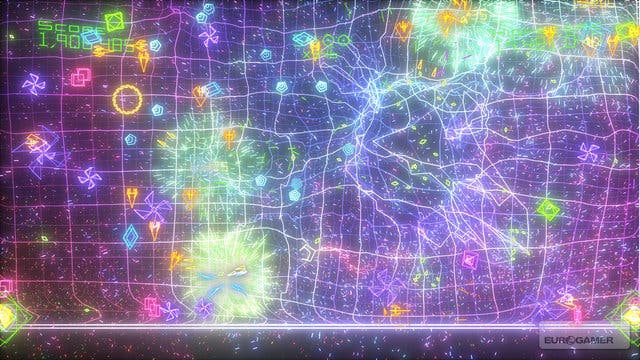Geometry Wars: Retro Explained
Bizarre's Stephen Cakebread does the maths.
It was weird, but we worked incredibly closely with them. We originally had it running on DS and Wii ourselves, we worked on a prototype. Vivendi wanted to take these versions up but we were just too busy. So it made sense for us to find someone we could work closely with.
It was kind of weird because we were a developer managing another developer - there was a publisher shield above it, but we were managing our IP. But they really got it, they understood the game quite early on.
It really came together in the end - we were worried for a time, but that's always the case with games, they always come together at the end. It was funny for us being on the outside. We're normally on the inside of that - we know what it's going to be like. But when we were on the outside we were like, oh my God, oh my God...
The main thing was we could explore things like different-shaped grids, which we'd always played with, but they didn't fit the structure of what was the Retro Evolved Geometry Wars. We could do things that worked well as a 10 minute event within Galaxies, but it didn't matter if it was just a 10 minute game because you could play the other 60 or so games in there.
With Galaxies, because every level can be different, it doesn't really matter if one of the levels is bastard hard.

The green ones that dodge your bullets were always a good one, because when they turned up, you had to start thinking about them. But what I generally found was, you would notice something when they started interacting and think OK, they're interacting in a nice way, and I'm going to play on that.
For example, the spinner ones, when I was initially testing them on their own and having them spawn with nothing else, worked quite well by having them track towards you. But when we had all the other enemies in there, especially the weavers, actually having them stay standing still almost like mines actually worked better. They're making half of the arena uninhabitable and you've got to clear them out because you can use that side of the arena again.
It's kind of a controlled randomness. Over every 20 to 30 seconds, I'll say I want two of these kinds of spawns to happen, and I'm only going to spawn these kinds of enemies within that period of time - to that level, it is controlled. So at the start of the game it's easy and at the end it's hard. But it is fairly random, it just makes an effort not to give you something bastard hard just by pure random chance.
That actually came from the first prototype for The Club, we had that in there. That worked really really well, it's a shame they couldn't put it in the final version. But it worked so well in that prototype we just wanted to find a way of putting it into Geometry Wars. It made sense... we wanted to make people feel like they were wanting to compete on score, because that's what Geometry Wars is all about, that's the motivation for playing it.

Absolutely. Certainly for Retro Evolved 1, where to get a high score they'd have to spend 20 to 30 hours playing the game. They'd be going to work, leaving their Xbox on, playing for 6 hours, going to sleep, playing the game all the time just to set these huge high scores. It's amazing they put that much effort it. I wouldn't. I look at that and wish I'd made it so you couldn't do that... but they're just taking what it is.
We're working on a few things, we can't really say yet. Something that's not directly related to twin-stick shooters. But Geometry Wars will be back as well.
Yeah, the casual games side is something that's here to stay. I mean Steve and we all work on other things at Bizarre as well. But we're playing around with a couple of other ideas that we're quite into at the moment. There will be more Geometry Wars, and there might be something different in between.
